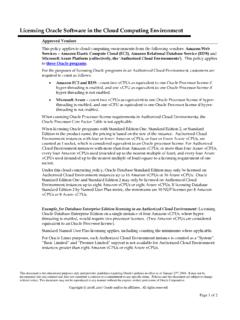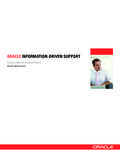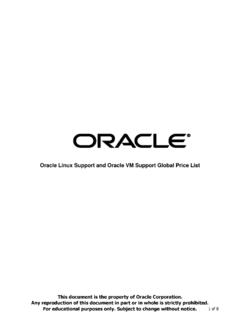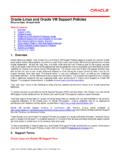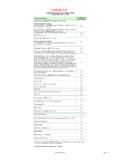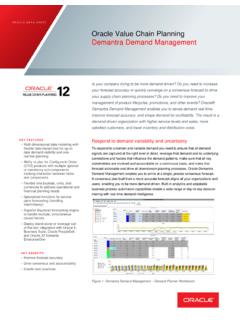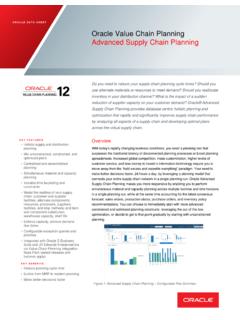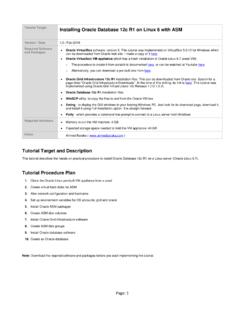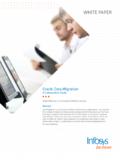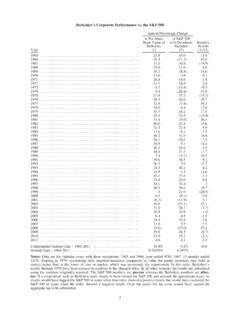Transcription of Migrating to Oracle Database
1 Migrating to Oracle Database your Guide to a Successful Migration, On-Premises or in the Cloud O R A C L E W H I T E P A P E R | F E B R U A R Y 2 0 1 7 Migrating TO Oracle Database 1 Introduction This paper provides an in-depth look at the process of Migrating third-party databases to Oracle Database 12c using Oracle SQL Developer tools. It will help you determine what s involved with converting a third-party Database to an Oracle Database instance, and also explain how to make your existing applications work with the finished product the migrated Oracle instance. You will learn how to create a migration repository, capture the source Database , convert it to the Oracle data type, and copy the data. The examples apply to on-premises and cloud scenarios, with attention to two cloud environments: Oracle Database Cloud Service (DBaaS) and Oracle Database Exadata Cloud Services.
2 Generally speaking, the process of Migrating data from a third-party RDBMS to Oracle Database is straightforward. Changing the architecture of your application so it can communicate with Oracle Database can be as simple as dropping in a new JDBC or ODBC driver. Moving stored procedures to Oracle s PL/SQL ecosystem is slightly more complicated. Every migration is different, and some applications require changes at the lowest levels of your technology stack. Asking the right questions up front is critical so you can identify potential roadblocks, and plan accordingly. This paper assumes you have access to Oracle Database or higher. If you have questions regarding Oracle Database licensing and pricing, please contact your Oracle account manager. Benefits of Migrating to Oracle Database Cloud Oracle Database 12c introduces several significant capabilities that significantly lower the cost and time required to migrate non- Oracle databases to the Oracle platform.
3 Oracle Database Cloud Service lets you choose pay-per-use metered services, or a regular monthly subscription of Oracle 11g, and Database services. You can automatically provision high availability configurations to elevate service levels for maintenance or unexpected failure scenarios. Provisioning choices include pre-packaged bundles of Oracle Database options for DevOps, Performance, Security, Analytics and Monitoring. The service comes with an integrated Oracle Application Express environment, allowing you move development activities to the cloud. Oracle Database 12c Multitenant makes it easy to consolidate many databases quickly and manage them as a cloud service. Identifying the Scope of your Migration Discussions regarding the migration to Oracle Database usually start with a series of questions: What Database are you Migrating from? (For example, SQL Server or DB2) o What version of this Database ?
4 If it s the latest version, SQL Server 2016, are you using any version-specific features? How many databases are you Migrating ? o If more than one, are they essentially copies of each other, or is each one a different migration? How large are your databases (amount of disk space for the data itself in GB/TB)? Do your Database applications rely heavily on stored procedures? o How many stored procedures and triggers need to be migrated? o Do they predominately fall under the select * from table return result set to application category? What is your migration project timeline, and when do you need to go Iive? Migrating TO Oracle Database 2 Will you be running the Oracle and third-party Database systems concurrently, with plans to fail over to the Oracle implementation? Will your new Database instance reside on-premises or in the cloud? What is the downtime/maintenance window, if any, allowed for this migration?
5 What is the nature of your homegrown applications (.NET, Java, etc.)? o Applications provided by an ISV generally have their own migration path If downtime isn t an option or you will be required to replicate Database changes to the original system for some time after your migration, consider using Oracle GoldenGate 12c to shorten the amount of time required to migrate the data. Database Migration Tools Oracle SQL Developer can help you identify the physical characteristics of the Database (s) you are Migrating . It is included with every copy of Oracle Database and also available for download on the Oracle Technology Network. This utility serves as a graphical user interface for Oracle Database and an integrated development environment for PL/SQL. Figure 1: SQL Developer version SQL Developer is also the official third-party Database migration solution for Oracle Database . It currently supports SQL Server, Sybase ASE, DB2, and Teradata.
6 It also assists with migrations from MySQL. For exact versions of supported databases, please consult the latest information on OTN. SQL Developer will capture the third-party Database definitions, analyze and convert those definitions to their Oracle equivalents, and provide the tools you need to move and verify the data. Here is a link to the supported JDBC drivers. SQL Developer provides a 9-step wizard that you can use to create a migration project, including setting up and running the capture and conversion processes of the source third-party Database . Migrating TO Oracle Database 3 Environment Setup You may be Migrating your data to Oracle Cloud or installing an in-house Oracle Database . Whether you are Migrating 1,000 databases or just one, it s best to start small to get a feel for the migration process and the tools. You will need the following: Oracle Database 12c, set up with a repository to store the project metadata (as described below) The latest version of SQL Developer The correct JDBC driver to connect to your third party Database Oracle provides a VirtualBox appliance, which includes Oracle Database 12c, the latest version of SQL Developer, and hands-on labs that present examples of how to migrate a Database .
7 The virtual machine is not certified or available for commercial use, but it is helpful for learning the ins and outs of performing an Oracle Database migration. Add Third-Party JDBC Drivers and Connect to your Source Database From the supported JDBC driver list, download the appropriate driver for your Database type. In SQL Developer, go to Preferences. On the Database page, select the Third Party JDBC Drivers page. Click Add and navigate to the appropriate jar file, as shown below. Figure 2: jtds is recommended for Sybase ASE and Microsoft SQL Server migrations. Once the driver has been successfully added, you can define a connection to databases that are compatible with that driver. Create a connection to your source Database . Verify that you can browse the objects and data to be migrated. In your target Oracle Database , create a new user/schema for the migration repository.
8 Define a SQL Developer connection to this schema so you can use it to create the repository. Launching the Wizard in SQL Developer In SQL Developer, go to the Tools menu and select Migration -> Migrating TO Oracle Database 4 This will launch a wizard that guides you through the process of creating a migration repository, capturing the objects, and performing the move to Oracle Database . You can create the repository in advance or you can do so via the wizard. Figure 3: The Migration Wizard The next page will ask you to pick your migration repository connection. Select the connection previously created, or create one now using the Create new connection button. The migration repository can be created in any Oracle instance. It does not have to be the same instance that you plan to migrate to. Next you will be prompted to name your project and select a directory for migration project output.
9 Select the third-party Database to be migrated. You have two options to access the data model a live connection and an offline model that is captured via shell scripts. The default selection is Online. Offline is for cases in which the engineer performing the migration does not have access to the source third-party Database . In this scenario, use the Tools > Migration > Create Database Capture interface. This command will generate either a Windows Batch file or a Linux Shell script for an administrator to run. It will capture the data model of the source Database and write it to files that can then be referenced in the Source Database page of the Migration Wizard. Migrating TO Oracle Database 5 Figure 4: Use Offline mode when you do not have access to the source third-party Database . Once a connection has been established, select one or more databases to migrate.
10 Determine the appropriate Oracle data types for the conversion. For example, the Sybase ASE data type DateTime will be stored as a Date in Oracle . Similarly, Time will be stored as Timestamp. You can override the defaults if you prefer to define your own data definition rules. Objects will be renamed in the migration process to avoid reserved word collisions and object name length limitations, such as the 30-character limitation in Oracle Database 12c Release 1. Apart from the data objects, SQL Developer will also translate constraints, views, functions, procedures, and triggers. The list of supported objects to be translated for each third-party databases can be found here. By default, SQL Developer will attempt to translate all available SQL objects that is, objects with embedded native SQL or T-SQL. Specifying the Target Database The Target Database Step allows you to specify how you would like to generate the migrated Oracle users and objects.

